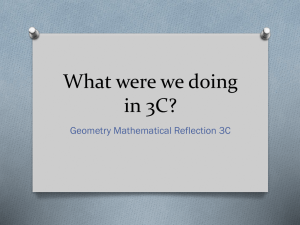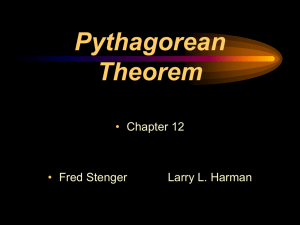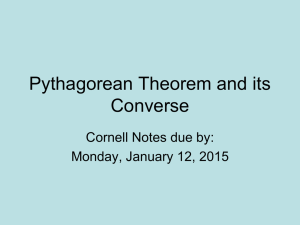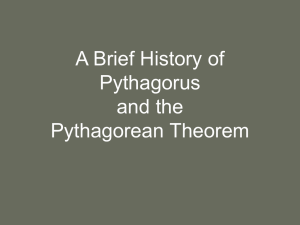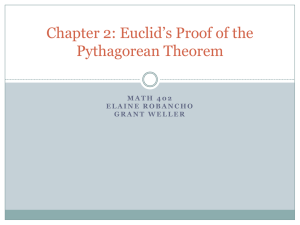Proof of the Pythagorean Theorem
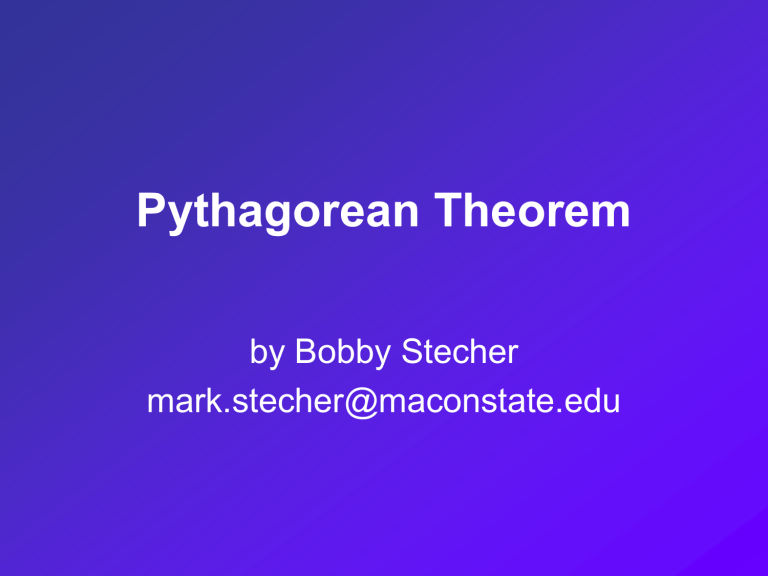
Pythagorean Theorem
by Bobby Stecher mark.stecher@maconstate.edu
The Pythagorean Theorem as some students see it.
c a b a 2 + b 2 = c 2
A better way a 2 a b b 2 c c 2 a 2 + b 2 = c 2
Pythagorean Triples
(3,4,5) (5,12,13) (7,24,25)
(8,15,17) (9,40,41) (11,60,61)
(12,35,37) (13,84,85) (16,63,65)
Pythagorean Triples
Pythagorean Triples http://www.cut-the-knot.org/Curriculum/Algebra/PythTripleCalculator.shtml
The distance formula.
b = y
2
-y
1
(x
1
,y
1
) c = distance a = x
2
-x
1
(x
2
,y
2
)
The Pythagorean Theorem is often easier for students to learn than the distance formula.
Proof of the Pythagorean Theorem from
Euclid
Euclid’s Proposition I.47 from
Euclid’s Elements.
Proof of the Pythagorean Theorem
Line segment CN is perpendicular to AB and segment CM is an altitude of
ΔABC.
Proof of the Pythagorean Theorem
Triangle ΔAHB has base AH and height AC.
Area of the triangle ΔAHB is half of the area of the square with the sides AH and AC.
Proof of the Pythagorean Theorem
Triangle ΔACG has base AG and height AM.
Area of the triangle ΔACG is half of the area of the rectangle
AMNG.
Proof of the Pythagorean Theorem equal to half of square ACKH.
AC is equal to AH because both are sides of the same square.
to rectangle AMNG.
Angle <CAG is equal to <HAB.
Both angles are formed by adding the angle <CAB to a right angle.
ΔACG is equal ΔAHB by SAS.
Proof of the Pythagorean Theorem
Triangle Δ MBE has base BE and height BC
Triangle Δ MBE is equal to half the area of square BCDE.
Proof of the Pythagorean Theorem
Triangle Δ CBF has base BF and height BM.
Triangle Δ CBF is equal to half the area of rectangle BMNF.
Proof of the Pythagorean Theorem
BA is equal to BF because both are sides of the same square.
Angle <EBA is equal to <CBF.
Both angles are formed by adding the angle <ABC to a right angle.
ΔABE is equal ΔFBC by SAS.
World Wide Web java applet for
Euclid’s proof.
http://www.ies.co.jp/math/java/geo/pythafv/y hafv.html
Additional Proofs of the
Pythagorean Theorem.
Proof by former president James Garfield. http://jwilson.coe.uga.edu/emt669/Student.Folders/Huberty.Gr
eg/Pythagorean.html
More than 70 more proofs.
http://www.cut-the-knot.org/pythagoras/
A simple hands on proof for students.
Step 1: Cut four identical right triangles from a piece of paper.
c a b
A simple hands on proof for students.
Step 2: Arrange the triangles with the hypotenuse of each forming a square.
a b b c c c c a b
Area of large square = (a + b) 2
Area of each part
4 Triangles = 4 x (ab/2)
1 Red Square = c 2
(a + b) 2 = 2ab +c 2 a 2 + 2ab + b 2 = 2ab +c 2 a 2 + b 2 = c 2 a b a
c b c
Alternate arrangement
a a a – b c c
Area of large square = c 2
Area of each part
4 Triangles = 4 x (ab/2)
1 Purple Square = (a – b) 2
(a – b) 2 + 2ab +c 2 a 2 – 2ab + b 2 + 2ab = c 2 a 2 + b 2 = c 2
The converse of the Pythagorean
Theorem can be used to categorize triangles.
If a 2 + b 2 = c 2 , then triangle ABC is a right triangle.
If a 2 + b 2 < c 2 , then triangle ABC is an obtuse triangle.
If a 2 + b 2 > c 2 , then triangle ABC is an acute triangle.
Cartesian equation of a circle.
x 2 + y 2 = r 2 is the equation of a circle with the center at origin.
Pythagorean Fractal Tree
Students can create a fractal using similar right triangles and squares
.
Using right triangles to calculate and construct square roots.
Was Pythagoras a square?
The sum of the area’s of the two semi circles on each leg equal to the area of the semi circle on the hypotenuse. The sum of the areas of the equilateral triangles on the legs are equal to the area of the equilateral triangle on the hypotenuse.
Extensions and Ideas for lessons
Does the theorem work for all similar polygons? Is there a trapezoidal version of the Pythagorean Theorem?
Using puzzles to prove the Pythagorean Theorem.
Make Pythagorean trees.
Cut out triangles and glue to poster board to demonstrate a proof of Pythagorean Theorem.
Create a list of Pythagorean triples and apply proofs to specific triples.
Use Pythagorean Theorem with the special right triangles.
Categorize triangles with converse theorem.
References
Boyer, Carl B. and Merzbach, Uta C. A History of Mathematics 2 nd ed . New York: John Wiley & Sons, 1968.
Burger, Edward B. and Starbird, Michael. Coincidences, Chaos, and All That Math Jazz . New York: W.W. Norton & Company, 2005.
Gullberg, Jan. Mathematics: From the Birth of Numbers . New
York: W.W. Norton & Company, 1997.
Livio, Mario. The Golden Ratio . New York: Broadway Books, 2002.
http://www.contracosta.edu/math/pythagoras.htm
http://www.cut-the-knot.org/ http://www.contracosta.edu/math/pythagoras.htm
Links
• http://www.contracosta.edu/math/pythagoras.htm
• http://www.cut-the-knot.org/
• http://www.contracosta.edu/math/pythagoras.htm
• http://www.ies.co.jp/math/java/geo/pythafv/yhafv.html
• http://jwilson.coe.uga.edu/emt669/Student.Folders/Hu berty.Greg/Pythagorean.html
• http://www.cut-the-knot.org/pythagoras/


